To work effectively with wood movement, understand that moisture changes cause it to expand or shrink mainly across its width, especially in warmer and more humid seasons. Selecting stable species, properly acclimating your wood, and controlling moisture with finishes help minimize issues. Using design features like gaps, floating panels, and sliding fasteners allows movement without damage. If you keep these principles in mind, you’ll be better equipped to produce durable, well-crafted projects—and there’s more to explore on managing these factors.
Key Takeaways
- Wood expands and contracts primarily across its width due to moisture content changes, especially seasonally.
- Selecting stable species and proper grain orientation reduces movement and warping risks.
- Acclimate wood to the final environment and maintain consistent moisture levels before working.
- Incorporate design features like gaps, floating panels, and sliding joints to accommodate movement.
- Finishing with moisture barriers and allowing space for expansion prevents cracking and joint failure.
The Fundamentals of How Wood Moves
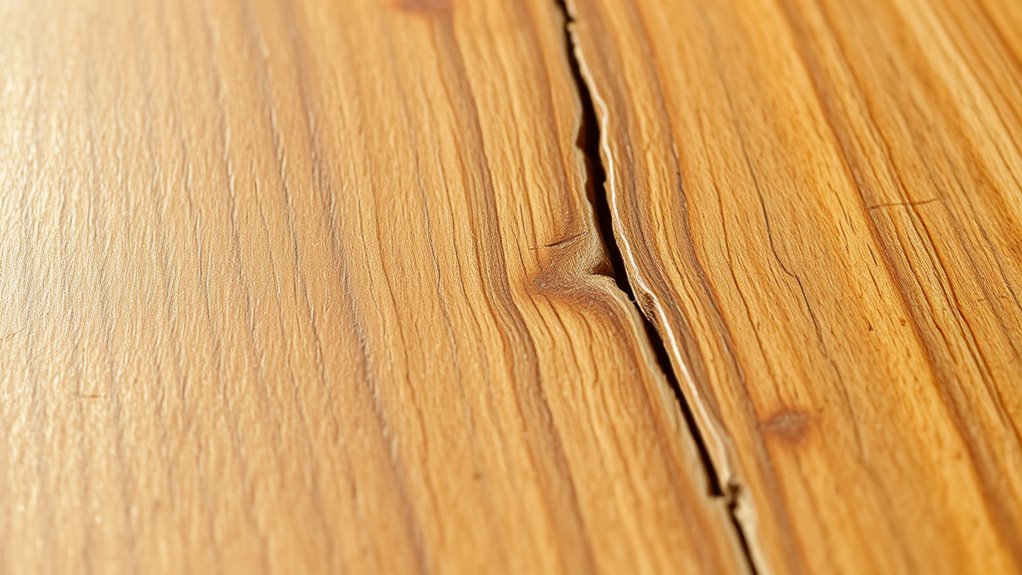
Have you ever noticed how wood changes size with the seasons? This is due to fluctuations in moisture content that cause expansion and contraction. As seasonal humidity rises in summer, wood absorbs moisture, leading to expansion; in winter, it loses moisture and contracts. Most wood movement happens across its width, specifically tangentially to the grain, which can cause warping or cupping if not managed properly. The amount of movement varies based on species, grain orientation, and whether the wood is flatsawn or quartersawn. Typically, this seasonal change results in movement around 1/32 to 3/32 inches per 6-inch width. Understanding these fundamentals helps you anticipate how moisture content influences wood’s dimensional stability throughout the year.
Why Grain Orientation Affects Stability
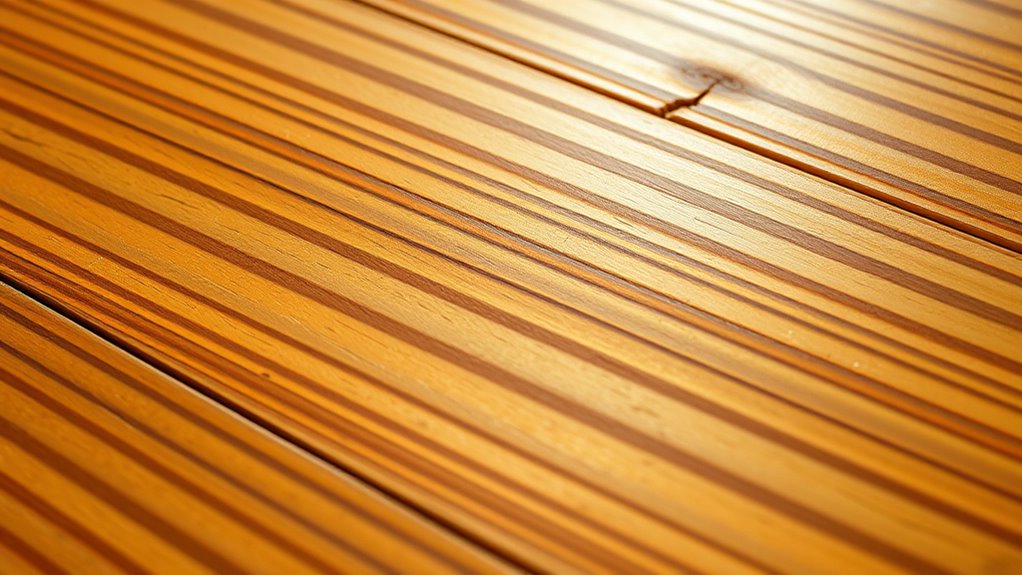
Grain orientation plays a essential role in how much a piece of wood will move with changes in moisture. Flatsawn boards, whose growth rings run parallel to the surface, tend to expand and contract most across their width due to tangential movement. This makes them less stable over time. In contrast, quartersawn lumber has growth rings that run more radially, providing greater stability and minimal movement across the width. The stability of your project depends heavily on this grain orientation, as radial grain resists dimensional changes better. Understanding how growth rings influence movement helps you design joints and assemblies that accommodate or minimize wood movement. Patterns of behavior can also influence how wood responds to environmental changes, making it important to consider these factors in your design. Quartersawn wood offers a reliable choice when stability is a priority, thanks to its grain orientation and reduced tendency to warp. Additionally, selecting appropriate wood types with specific grain patterns can further enhance the stability of your project.
Factors That Influence the Extent of Movement
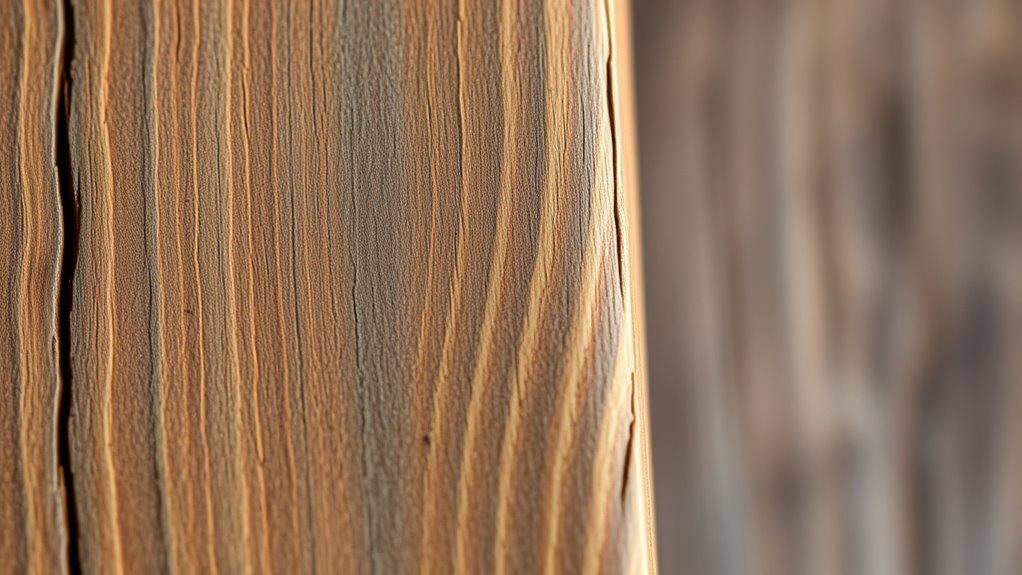
The amount of wood movement you can expect depends on several key factors. Moisture content is a primary driver, as fluctuations caused by seasonal changes impact how much a piece expands or contracts. The wood species plays a role; high-moisture-content woods like oak, hickory, and hard maple tend to move more than cherry, walnut, or butternut. Grain direction influences stability, with quarter-sawn wood being more resistant to movement than flat-sawn. Larger boards experience greater shifts, especially in width. Seasonal fluctuations in humidity alter the equilibrium moisture content (EMC), determining the maximum potential movement. The higher the EMC, the more the wood will expand; lower EMC causes contraction. Proper drying techniques can also significantly reduce unexpected movement by controlling initial moisture levels. Additionally, understanding wood anatomy helps in predicting how different parts of the wood will respond to moisture changes. Furthermore, selecting appropriate wood processing methods can enhance stability and minimize movement over time. Paying attention to initial moisture content during the drying process is crucial for achieving consistent behavior in finished wood products. Properly managing climate conditions during storage and use can further help mitigate excessive movement and maintain stability over time.
Selecting and Preparing Wood for Stability
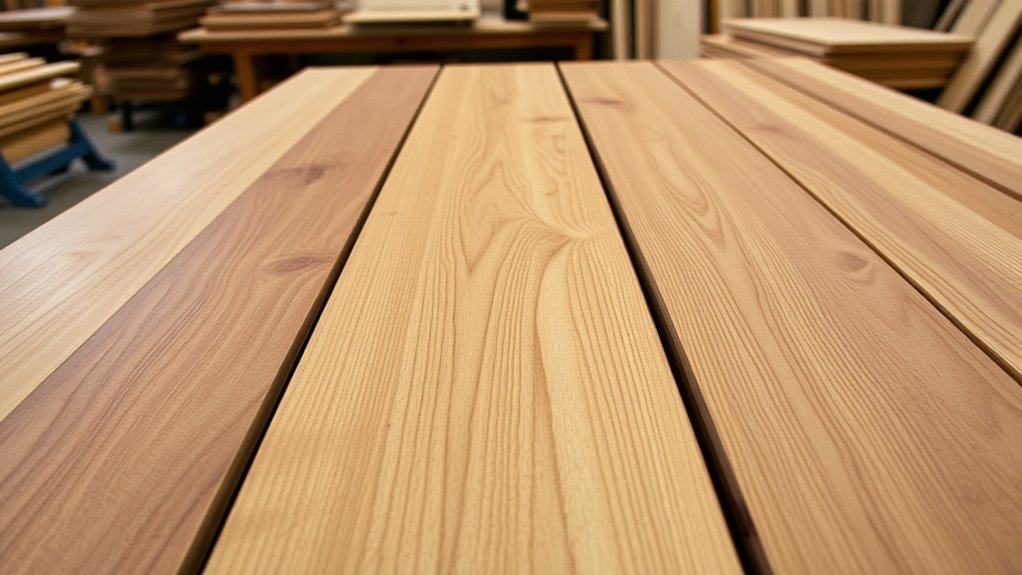
Choosing the right wood species and ensuring proper moisture content are key to stability. Look for kiln-dried, low-moisture lumber marked KD or S-DRY, and measure its moisture with a meter before using it. Acclimate your wood in its final environment for at least a week or two to minimize future movement. Using wood movement can be an excellent way to support your health and energy levels during the woodworking process. Additionally, understanding how moisture content affects wood behavior helps in selecting materials that will stay stable over time.
Choosing Stable Species
Selecting the right wood species is essential for ensuring stability in your project, as some woods naturally resist movement better than others. Stable species like cherry, walnut, and butternut tend to move less because of their lower coefficients of moisture-related expansion. Quartersawn wood also offers greater stability than flatsawn, since its growth rings run vertically, reducing tangential shrinkage. Ensuring your wood’s moisture content is close to the project’s environment—around 6-8%—minimizes future expansion and contraction. Properly acclimating your wood by measuring its moisture content with a moisture meter helps confirm it’s ready for use. Choosing wood with a consistent, tight grain pattern further reduces the likelihood of uneven movement and cracking over time, making your project more durable and stable. Incorporating wood with stable characteristics can further enhance your project’s resilience over time. Additionally, understanding how wood movement occurs allows you to anticipate and accommodate natural shifts, leading to more successful woodworking outcomes. Being aware of moisture content and controlling it during storage and use helps prevent unforeseen movement and warping. Recognizing the importance of climate control in your workspace can also help maintain consistent moisture levels, reducing the risk of future issues.
Proper Moisture Content Levels
Ensuring your wood has the proper moisture content is crucial for stability and durability. Selecting kiln-dried lumber with moisture content close to the final environment’s equilibrium moisture content (EMC) minimizes wood movement and warping. Using a moisture meter helps verify the current moisture level, ensuring the wood is properly acclimated before working. Allowing the wood to sit in its final environment for one to two weeks helps reach EMC, reducing dimensional shifts over time. Proper storage and conditioning are key, with ideal moisture levels between 6-8% indoors or 8-12% outdoors. Remember:
| Moisture Content | Environment | Result |
|---|---|---|
| 6-8% | Indoor | Stable, minimal movement |
| 8-12% | Outdoor | Stable, minimal movement |
| Higher than EMC | Too wet | Expansion, warping |
| Lower than EMC | Too dry | Shrinkage, cracking |
Additionally, understanding wood movement helps in planning projects and selecting the right moisture levels to prevent warping or splitting over time. Being aware of how moisture content affects wood behavior can also guide you in making informed decisions during construction. Properly accounting for wood expansion and contraction is essential to avoid issues as environmental conditions change. Recognizing how environmental humidity influences moisture levels can further enhance your ability to maintain wood stability in your greenhouse. Furthermore, understanding seasonal changes and their impact on moisture levels can help you anticipate and mitigate potential problems.
Design Strategies to Accommodate Movement

To prevent cracks and warping, you should incorporate gaps like expansion joints or sliding dovetails into your design. Using floating panels and allowing for movement with proper fasteners helps maintain stability while accommodating seasonal changes. Additionally, designing allowances in joinery, such as pegs and slots, guarantees your pieces can expand and contract without damage. Properly managing wood movement is essential for the longevity and safety of your woodworking projects. Employing natural materials like wood with controlled moisture content can also minimize issues related to seasonal expansion and contraction, especially when selecting woods with predictable dimensional stability. Moreover, ongoing monitoring of AI behavior in modern tools can alert you to potential issues before they affect your work.
Incorporate Expansion Gaps
Incorporating expansion gaps is essential for allowing wood to move naturally with seasonal changes. These gaps, at least 1/8 inch, help prevent warping or cracking in your woodworking project. To effectively allow for expansion, consider these strategies:
- Leave space around panels and framing to accommodate seasonal movement.
- Use fasteners like figure-8 fasteners or Z-clips that enable panels and tabletops to expand and contract without stress.
- Design wide surfaces with built-in allowances, such as floating joints or extra space, to prevent warping.
- Be aware of wood movement and its causes to better anticipate and accommodate changes in your projects.
Use Movement-Resilient Joinery
Using movement-resilient joinery techniques allows your woodworking projects to accommodate wood expansion and contraction naturally. By choosing joinery methods like floating panels and breadboard ends with pegs and slots, you enable wood to respond to moisture content changes without stress or damage. Sliding dovetails and tongue-and-groove joints permit movement along the grain while maintaining strength. Designing joints with elongated screw or dowel holes, such as slots or oversized holes, helps manage seasonal expansion and contraction. Fasteners like figure-8 clips or Z-clips can pivot or slide, allowing attached components to move freely with wood changes. Avoid rigid miter joints outdoors or in large panels, opting instead for joinery that provides lateral movement, preventing cracking, warping, or splitting caused by wood movement.
Finishing Techniques That Help Control Movement
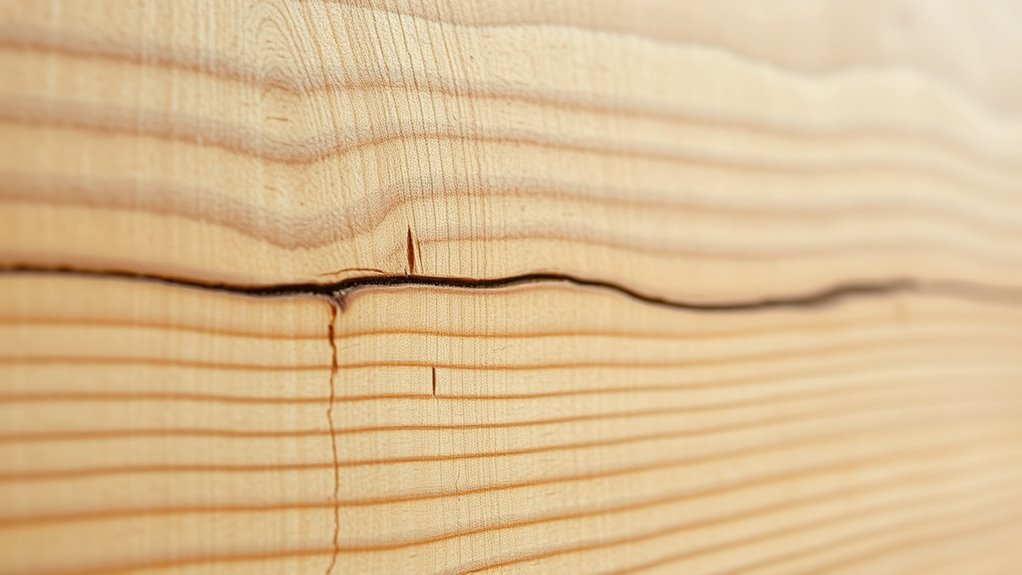
Have you considered how your finishing choices can influence wood movement? Proper finishing techniques can help you control dimensional stability by creating effective moisture barriers. To minimize wood movement, focus on:
Choosing the right finish helps control moisture and reduces wood movement over time.
- Applying sealants like shellac or varnish that penetrate deeply, stabilizing moisture content.
- Using heavier finishes such as urethane or lacquer to slow moisture exchange and reduce expansion and contraction.
- Finishing panels before assembly to prevent edges from showing shrinkage gaps and maintain overall stability.
Light finishes, like wax or oil, allow more moisture movement and increase the risk of warping. By sealing surfaces properly, you can considerably decrease seasonal changes, preserving your woodwork’s integrity over time.
Practical Tips for Managing Seasonal Changes
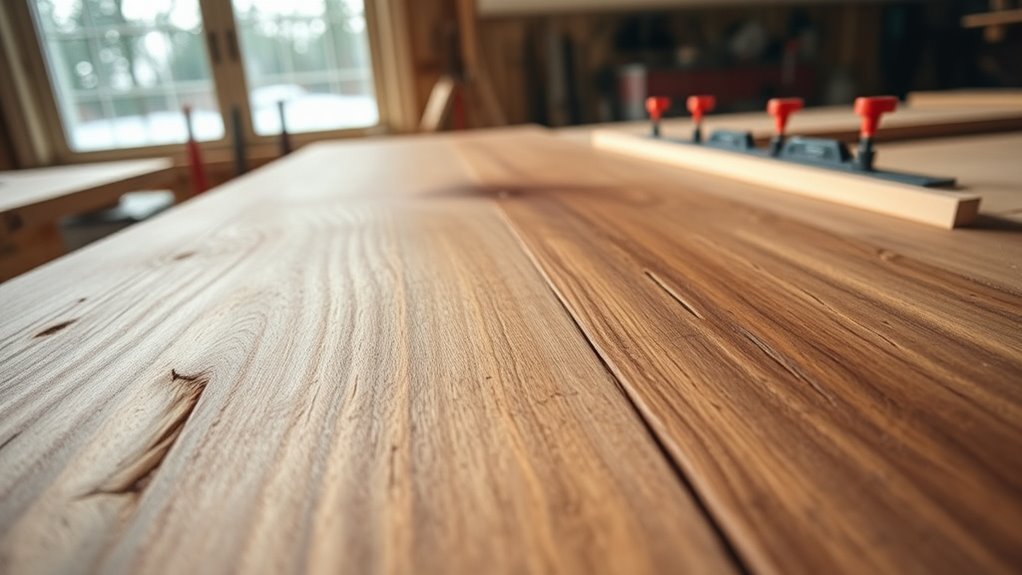
To effectively manage seasonal wood movement, you should incorporate design features like gaps, expansion joints, or slots that provide space for the wood to expand and contract naturally. Acclimating wood in its final environment for at least one to two weeks helps match moisture content (EMC), reducing unexpected movement. Use stable wood, such as quarter-sawn stock, for critical parts to minimize warping. Installing expansion joints or slots allows seasonal movement without cracking or buckling. Fasteners like figure-8s, Z-clips, or slotted screws enable wood to slide or pivot, accommodating moisture-driven changes. Below is a table illustrating key strategies:
| Strategy | Application | Benefit |
|---|---|---|
| Gaps & Slots | Between panels or joints | Prevents cracks |
| Acclimate Wood | Before installation | Ensures stable moisture |
| Use Stable Wood | For critical components | Reduces movement risk |
| Expansion Joints | In large surfaces | Allows seasonal movement |
| Appropriate Fasteners | For sliding or pivoting | Maintains integrity |
Common Challenges in Furniture and Construction

Many common challenges in furniture and construction stem from failing to account for seasonal wood movement. When moisture content fluctuates, wood expands and contracts, leading to issues like joint failure and warping. To prevent problems, you should be aware of these key challenges:
Ignoring seasonal wood movement causes warping, gaps, and joint failure in furniture and structures.
- Wide panels and tabletops may develop gaps, splits, or cupping if movement isn’t planned for.
- Improperly fitted hardware, such as hinges and locks, can cause sticking or damage as wood shifts throughout the year.
- Outdoor structures without proper gaps, sealants, or joinery allow moisture changes to induce cracking or warping.
Ignoring seasonal variation can result in misaligned joints, cracked panels, and compromised durability. Proper planning and understanding of wood movement help you create long-lasting, stable furniture and structures.
Calculating and Planning for Wood Movement
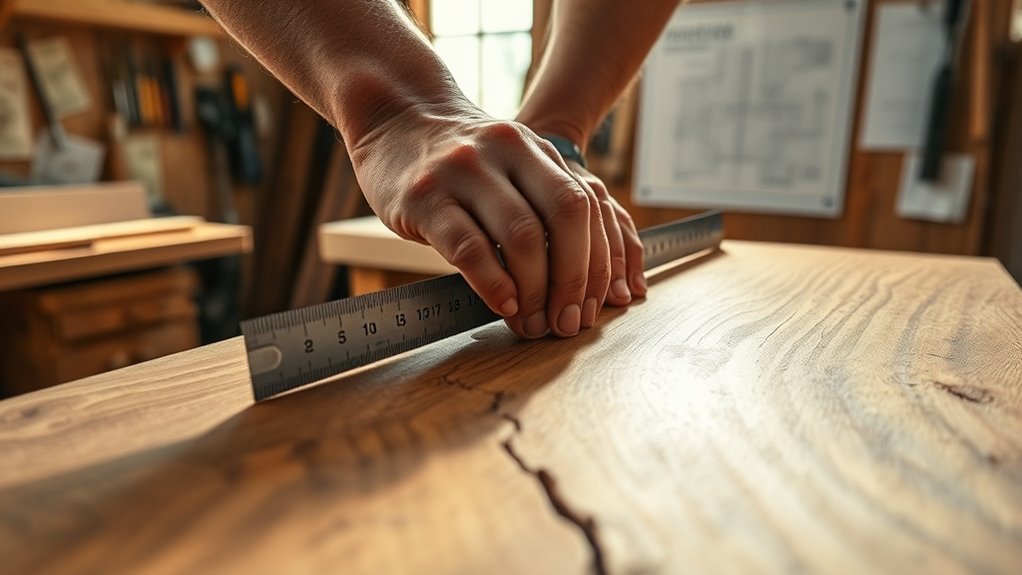
Understanding how to calculate and plan for wood movement is essential for creating durable furniture and structures. Start by measuring the seasonal equilibrium moisture content (EMC) in your area, which indicates the typical moisture level wood will reach. Use this value to determine the moisture change your wood will experience. To predict dimensional movement, apply the formula: (Width of board) x (coefficient) x (change in moisture). Coefficients vary by species and sawing method and can be found on detailed charts. This calculation helps you anticipate wood expansion or contraction. Incorporate design allowances like gaps, floating panels, or sliding fasteners to accommodate this movement. Proper planning guarantees your project remains stable, preventing warping, cracking, or other issues caused by moisture-driven dimensional changes.
Frequently Asked Questions
What Is the Job Called When You Work With Wood?
When you work with wood, your job can be called a woodworker or carpenter, depending on what you focus on. As a woodworker, you craft furniture, cabinetry, and detailed projects. If you’re building structures like houses, you’re a carpenter. Both roles require using tools skillfully, understanding how wood behaves, and applying joinery techniques to guarantee your creations are durable and beautiful. Your expertise shapes high-quality wood products every day.
How to Stop Wood Movement?
You can’t completely stop wood movement because moisture changes are natural, but you can minimize its effects. Seal and finish your wood properly to reduce moisture exchange, and choose stable materials like plywood. Design joints with allowances, maintain consistent humidity levels, and select low-movement species. Using these techniques helps you control wood movement, keeping your projects looking great and lasting longer.
How to Tell Which Way Wood Grain Is Going?
To tell which way the wood grain runs, look at the surface and end grain. Run your fingers along it—if it feels smooth and fibers slide easily, you’re following the grain. Check the end grain: flat-sawn boards have wavy rings, while quartersawn boards show narrow, straight rings. Use a sharp knife or awl to scratch lightly; the scratch lines should follow the grain direction, confirming how it runs.
What Direction Does Wood Move the Most?
It’s ironic, but the direction you’d think wood would move most isn’t the one it actually does. You might guess along its length, yet it’s across the grain that wood moves the most—especially tangentially to growth rings. You’ll notice this seasonal swelling and shrinking, often up to 1/32 inch per six inches. Quartersawn wood stays more stable, but flatsawn boards can surprise you with their significant dimensional changes.
Conclusion
So, now that you’re a wood movement expert, go ahead—build that shaky table or wobbly chair with confidence. Who needs stability anyway? Just pretend wood behaves itself, ignore seasonal changes, and hope for the best. After all, if your furniture starts to dance, you can always say it’s just adding a little flair. Remember, mastering wood movement isn’t just smart—it’s the secret to furniture that keeps you guessing!









